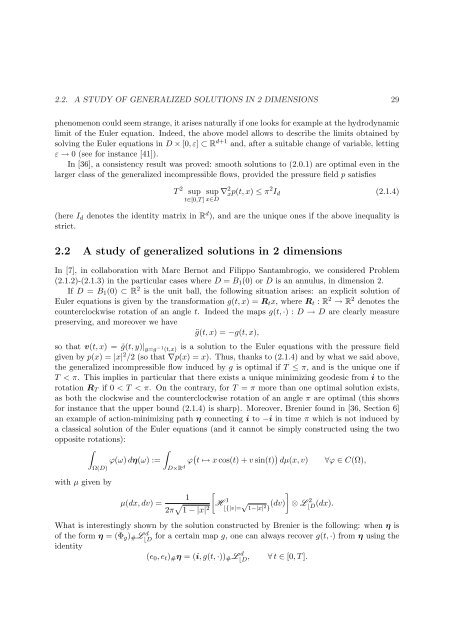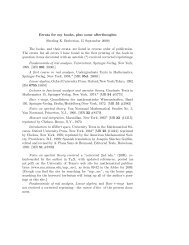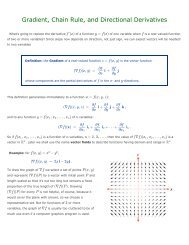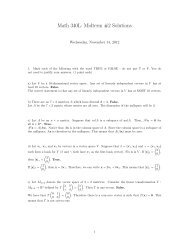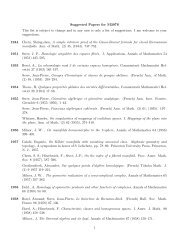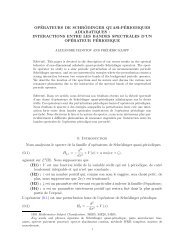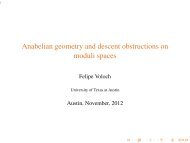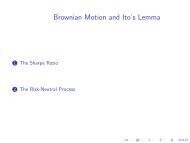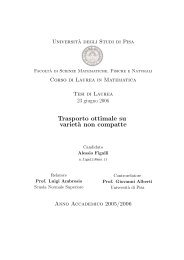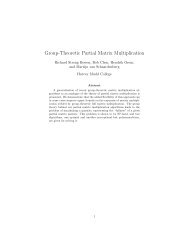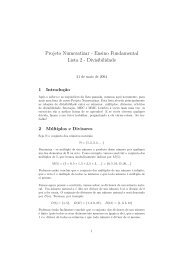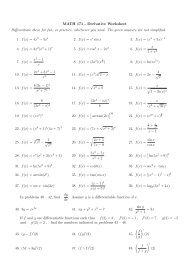Optimal transport, Euler equations, Mather and DiPerna-Lions theories
Optimal transport, Euler equations, Mather and DiPerna-Lions theories
Optimal transport, Euler equations, Mather and DiPerna-Lions theories
Create successful ePaper yourself
Turn your PDF publications into a flip-book with our unique Google optimized e-Paper software.
2.2. A STUDY OF GENERALIZED SOLUTIONS IN 2 DIMENSIONS 29<br />
phenomenon could seem strange, it arises naturally if one looks for example at the hydrodynamic<br />
limit of the <strong>Euler</strong> equation. Indeed, the above model allows to describe the limits obtained by<br />
solving the <strong>Euler</strong> <strong>equations</strong> in D × [0, ε] ⊂ R d+1 <strong>and</strong>, after a suitable change of variable, letting<br />
ε → 0 (see for instance [41]).<br />
In [36], a consistency result was proved: smooth solutions to (2.0.1) are optimal even in the<br />
larger class of the generalized incompressible flows, provided the pressure field p satisfies<br />
T 2 sup<br />
sup ∇<br />
t∈[0,T ] x∈D<br />
2 xp(t, x) ≤ π 2 Id<br />
(2.1.4)<br />
(here Id denotes the identity matrix in R d ), <strong>and</strong> are the unique ones if the above inequality is<br />
strict.<br />
2.2 A study of generalized solutions in 2 dimensions<br />
In [7], in collaboration with Marc Bernot <strong>and</strong> Filippo Santambrogio, we considered Problem<br />
(2.1.2)-(2.1.3) in the particular cases where D = B1(0) or D is an annulus, in dimension 2.<br />
If D = B1(0) ⊂ R 2 is the unit ball, the following situation arises: an explicit solution of<br />
<strong>Euler</strong> <strong>equations</strong> is given by the transformation g(t, x) = Rtx, where Rt : R 2 → R 2 denotes the<br />
counterclockwise rotation of an angle t. Indeed the maps g(t, ·) : D → D are clearly measure<br />
preserving, <strong>and</strong> moreover we have<br />
¨g(t, x) = −g(t, x),<br />
so that v(t, x) = ˙g(t, y)| y=g−1 (t,x) is a solution to the <strong>Euler</strong> <strong>equations</strong> with the pressure field<br />
given by p(x) = |x| 2 /2 (so that ∇p(x) = x). Thus, thanks to (2.1.4) <strong>and</strong> by what we said above,<br />
the generalized incompressible flow induced by g is optimal if T ≤ π, <strong>and</strong> is the unique one if<br />
T < π. This implies in particular that there exists a unique minimizing geodesic from i to the<br />
rotation RT if 0 < T < π. On the contrary, for T = π more than one optimal solution exists,<br />
as both the clockwise <strong>and</strong> the counterclockwise rotation of an angle π are optimal (this shows<br />
for instance that the upper bound (2.1.4) is sharp). Moreover, Brenier found in [36, Section 6]<br />
an example of action-minimizing path η connecting i to −i in time π which is not induced by<br />
a classical solution of the <strong>Euler</strong> <strong>equations</strong> (<strong>and</strong> it cannot be simply constructed using the two<br />
opposite rotations):<br />
<br />
<br />
ϕ(ω) dη(ω) := ϕ t ↦→ x cos(t) + v sin(t) dµ(x, v) ∀ϕ ∈ C(Ω),<br />
Ω(D)<br />
with µ given by<br />
D×R d<br />
1<br />
µ(dx, dv) =<br />
2π 1 − |x| 2<br />
<br />
H 1<br />
⌊{|v|= √ 1−|x| 2 } (dv)<br />
<br />
⊗ L 2<br />
⌊D (dx).<br />
What is interestingly shown by the solution constructed by Brenier is the following: when η is<br />
of the form η = (Φg)#L d<br />
⌊D for a certain map g, one can always recover g(t, ·) from η using the<br />
identity<br />
(e0, et)#η = (i, g(t, ·))#L d<br />
⌊D , ∀ t ∈ [0, T ].


